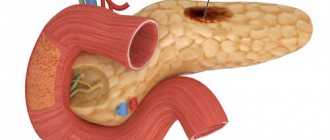Causes of pancreatic enzyme deficiency
Anatomically, the pancreas consists of a head, body and tail.
The pancreatic tissue consists of lobules united by strands of connective tissue. The pancreas performs endocrine and exocrine functions. The endocrine function consists of the production of insulin and glucagon - hormones that regulate carbohydrate metabolism, the exocrine function - in the formation and deposition of enzymes that break down nutrients.
When food enters the gastrointestinal tract, the pancreas secretes enzymes that enter the small intestine, as well as bicarbonates that neutralize hydrochloric acid and maintain an alkaline environment in the duodenum, necessary for the normal functioning of the pancreas.
Normally, the pancreas secretes pancreatic juice in amounts from 50 to 250 ml (depending on age). With the help of pancreatic enzymes (amylase, lipase, proteases), nutrients are broken down, starting from the duodenum and further into the intestinal cavity.
A variety of reasons can lead to the development of relative enzyme deficiency:
- damage to gland cells by drugs;
- metabolic disorders (metabolic processes);
- infections;
- obstruction (damage) of the pancreatic duct;
- congenital pathologies of the pancreas;
- insufficient activation of enzymes due to bile deficiency;
- dyskinesia of the duodenum and small intestine, as a result of which the mixing of enzymes with the food bolus is disrupted;
- disturbance of intestinal flora (dysbacteriosis);
- protein deficiency;
- cholelithiasis, celiac disease, inflammatory bowel diseases (ulcerative colitis and Crohn's disease);
- absolute pancreatic insufficiency is caused by a decrease in the volume of the functioning pancreas.
Lactase deficiency in children
In case of primary lactase deficiency, first of all, reduce the amount of lactose in the diet or even completely eliminate it. At the same time, it is necessary to correct intestinal dysbiosis and eliminate other symptoms.
In case of secondary lactase deficiency in children, you first need to cure the underlying disease, which lies at the root of the problem. Temporarily reduce the amount of lactose consumed in food so that the mucous membrane of the small intestine is restored.
The product that contains the maximum amount of lactose is whole milk. It should be excluded from the diet of a sick child. You can include butter, dairy products and hard cheeses in your diet. It is necessary to pay attention to the fact that less calcium will be supplied with food than before eliminating milk.
In infancy, it is more difficult to adjust the diet. If a child is fed from the mother's breast, it is not advisable to reduce the amount of milk. In such cases, doctors often recommend using lactase preparations mixed with expressed breast milk.
Lactase-Baby in capsules is added to the first portion of expressed milk, which should sit for 3-4 minutes. The dose of lactase for infants is at least 1 capsule per 100 ml of milk. Lactase-Baby for lactase deficiency is given during each feeding. After the baby has drunk a portion of expressed milk with the drug, he is breastfed.
If it is impossible to use lactose preparations, low-lactose mixtures are prescribed. If the child is breastfed, select a formula with the maximum amount of lactose that does not cause symptoms and does not increase the carbohydrate content in the feces.
If the child is in normal condition, without toxicosis or exicosis, and if the carbohydrate content in feces is not higher than 0.3-0.6%, it is recommended to start with a diet that contains up to 2/3 of carbohydrates in the form of lactose. You can combine the adapted mixture with a low-lactose one or take Lactofidus fermented milk mixture. The latter contains 5.3 g of lactose per 100 ml, lactase activity is fixed.
After changing diets, fecal carbohydrate levels are monitored after 1 week to determine whether lactose intake needs to be further reduced.
If the baby is premature and the stool contains a significantly higher amount of carbohydrates than normal, formulas such as Enfalak, Alprem, Frisopre are used for feeding. They form the basis of the diet.
In cases of severe lactase deficiency, or if reducing lactose intake by 2 times has not had any effect, low-lactose mixtures are used, for example, Nutrilon low-lactose.
In advanced cases, as well as for premature infants with an unclear cause of lactase deficiency and impaired food tolerance, mixtures based on partial or complete protein hydrolyzate are prescribed until the cause of the disease is eliminated.
After this, the diet is expanded, the child is given more lactose (by 1/3, then by ½). Carbohydrate excretion is monitored weekly.
Soy formula is not recommended for premature infants. In any form of lactase deficiency, the content of carbohydrates in stool should be regularly monitored. If disturbances recur, reduce the amount of lactose consumed by the child.
Symptoms of pancreatic enzyme deficiency
- loose stools;
- flatulence;
- stomach ache;
- nausea and recurrent vomiting;
- decreased appetite;
- general weakness;
- decreased physical activity;
- weight loss;
- growth retardation in children, with severe forms of failure.
An important diagnostic sign of pancreatic enzyme deficiency is, first of all, a change in stool character, since manifestations of lipase enzyme deficiency develop before a decrease in the activity of other enzymes (amylase and proteases). According to experimental calculations, lipase deficiency in the manifestation of pathology can reach 300 thousand units per day. The stool becomes voluminous and profuse (polyfecal matter), feces become grayish, greasy (poorly washed off), and a fetid, putrid odor appears.
Lactose intolerance and dysbiosis
There is another reason for infants’ intolerance to milk sugar, and I would like to dwell on it separately. Thus, lactase deficiency is often a direct consequence of the presence of intestinal dysbiosis in the baby . The reason for problems with microflora is precisely that the child receives a lot of lactose with the “front” milk and does not suck out the “hind” milk, which is fattier and more nutritious and less “sweet”. The baby's unformed enzymatic system is not able to digest large amounts of milk sugar. As a result, fermentation processes begin in the intestines, since lactose is food not only for beneficial bifidobacteria and lactobacilli, but also for pathogenic microflora.
Thus, the basis of dysbiosis is an imbalance in the feeding of the child, as a result of which he receives more “foremilk”. This explains the fact that in the first days after birth, babies have virtually no abdominal pain, since they are fed fatty colostrum, which has a low sugar content. When, two weeks after birth, the milk becomes mature, complaints about bloating and intestinal problems in infants become many times more numerous. Hence the typical symptoms...
Treatment of pancreatic enzyme deficiency
If symptoms of pancreatic enzymatic insufficiency are detected, it is necessary to begin replacement therapy with pancreatic enzymes as early as possible, before the development of more serious symptoms.
Treatment of pancreatic insufficiency is aimed at eliminating disturbances in the digestion of fats, proteins and carbohydrates and includes the appointment of an appropriate high-calorie diet and replacement therapy with multienzyme drugs.
The dose and duration of taking the enzyme preparation are selected individually and depend on the severity of the deficiency - symptoms, body weight, age, content of the active substance in the drug and its release form.
At GUTA CLINIC it is possible to conduct a full range of laboratory diagnostics to identify the causes of the development of pancreatic enzymatic insufficiency. Diagnostics are carried out using expert equipment made in America and Europe from leaders in the creation of premium medical equipment. Experienced specialists, in accordance with individual indications, will select the optimal treatment regimen that you need and very quickly bring your health back to normal.
Amount of lactose in products
Using a special list of products, you can determine the amount of lactose present in the diet. Below are data from various authors.
Lactose content in some products in grams per 100 g of product (T. Schleip, 2004):
- Dessert cream - 2.8–6.3.
- Coffee whitener - 10.0.
- Yogurt made from powdered milk - 4.7.
- Whole milk yogurt (3.5%) - 4.0.
- Milk yogurt (1.5%) - 4.1.
- Milk yogurt (3.5%) - 4.0.
- Natural yogurt - 3.2.
- Creamy yogurt - 3.7.
- Low-fat fruit yogurt - 3.1.
- Low-fat fruit yogurt - 3.0.
- Yogurt ice cream - 6.9.
- Creamy fruit yogurt - 3.2.
- Cocoa - 4.6.
- Mashed potatoes - 4.0.
- Semolina porridge - 6.3.
- Rice porridge with milk - 18.0.
- Kefir - 6.0.
- Low-fat kefir - 4.1.
- Sausages - 1.0–4.0.
- Margarine - 0.1.
- Butter - 0.6.
- Sour milk - 5.3.
- Low-fat milk - 4.9.
- Pasteurized milk (3.5%) - 4.8.
- Condensed milk (7.5%) - 9.2.
- Condensed milk (10%) - 12.5.
- Condensed milk with sugar - 10.2.
- Powdered milk - 51.5.
- Skimmed milk powder - 52.0.
- Whole milk (3.5%) - 4.8.
- Whole milk powder - 38.0.
- Milkshakes - 5.4.
- Milk chocolate - 9.5.
- Ice cream - 6.7.
- Dairy ice cream – 1.9–7.0.
- Ice cream sundae - 1.9.
- Creamy ice cream - 5.1–6.9.
- Fruit ice cream - 5.1–6.9.
- Nougat - 25.0.
- Buttermilk - 3.5.
- Dry buttermilk – 3.5.
- Donuts - 4.5.
- Pudding - 2.8–6.3.
- Whipped cream (10%) - 4.8.
- Whipped cream (30%) - 3.3.
- Coffee creamer (10%) - 3.8.
- Pasteurized cream - 3.3.
- Pasteurized whole cream - 3.1.
- Sour cream (10%) - 2.5.
- Dry whey – 70.0.
- Gouda cheese (45%) - 2.0.
- Camembert cheese (45%) - 0.1–3.1.
- Mozzarella cheese - 0.1–3.1.
- Parmesan cheese - 0.05–3.2.
- Roquefort cheese - 2.0.
- Steppe cheese - 0.1.
- Cottage cheese (20%) - 2.7.
- Cottage cheese (40%) - 2.6.
- Low-fat cottage cheese - 3.2.
Lactose content in some products in grams per 100 g of product (I.M. Skurikhin, M.I. Volgarev, 1987):
- Buckwheat groats - 0.03.
- Oatmeal - 0.05.
- Oatmeal - 0.02.
- Winter wheat - 0.05.
- Soft spring wheat - 0.02.
- Women's milk - 6.6–7.0 (cow's milk - 4.8, sterilized cow's milk - 4.7, mare's milk - 5.8, sheep's - 4.8, goat's - 4.5, camel's - 4.9, dry whole - 37.5, dry low-fat - 49.3).
- Full-fat kefir - 3.6.
- Yogurt - 4.1.
- Acidophilus - 3.8.
- Yogurt - 3.5.
- Kumis - 5.0.
- Pasteurized buttermilk - 4.7.
- Dry cream - 26.3.
- Sterilized cream (25%) - 3.3.
- Condensed milk with sugar - 12.5.
- Condensed milk without sugar - 9.5.
- Low-fat cottage cheese - 1.8.
- Fat cottage cheese - 2.8.
- Cream (10%) - 4.0.
- Cream (20%) - 3.7.
- Sour cream (30%) - 3.1.
- Cocoa with condensed milk and sugar - 11.4.
- Coffee with condensed milk and sugar - 9.0.
- Coffee with condensed cream and sugar - 9.0.
- Hard cheeses (the indicator depends on the fat content of the product) - 2.0–2.8.
- Cheese cheese - 2.9.
- Oil of traditional composition - 0.81 (“Peasant” - 1.35, “Buterbrodnoe” - 1.89).
- Creamy ice cream - 5.8.
- Dry milk mixture low-lactose, with rice flour - 0.36, with buckwheat flour - 0.36, with oatmeal - 0.36.
Products that almost always contain milk sugar:
- Milk and dairy products.
- Packaged sausages, including cooked ham.
- Soups in bags.
- Ready-made sauces.
- Bakery products.
- Nut butter.
- Ice cream.
- Breadcrumbs.
- Cakes and pies.
- Dumplings.
- Croquettes with cheese.
- Hamburgers.
- Cheeseburgers.
- Ham.
- Ketchup.
- Mustard.
- Mayonnaise.
- Flavor enhancers.
- Astringent component for making sauces.
- Sweeteners in prepared packaged foods.
- Condensed milk.
- Bulk spices.
- Chocolate bars, sweets such as candies, chocolate (with the exception of some varieties of dark chocolate).
- Cocoa powder.
- Nutritional supplements.
- Light sauces.
- Puddings, puree soups.
- Donuts and omelettes.
- Mashed potatoes.
- Saccharin tablets.
Products approved for use in lactase deficiency:
- Soy milk and soy drinks.
- Low lactose milk formulas.
- Raw meat, poultry, fish.
- Eggs.
- Lard.
- Vegetable oil.
- All fruits and vegetables.
- Potato.
- Cereals (rice, etc.).
- Legumes.
- Nuts.
- Jam, honey, syrups.
- Any type of sugar except milk (sorbitol, fructose).
- Liquid saccharin.
- Fruit and vegetable juices.
- Tea coffee.
- Pasta made from wheat flour without additives.
- Natural flour.
- Rye and wheat bread without whey and food additives.








